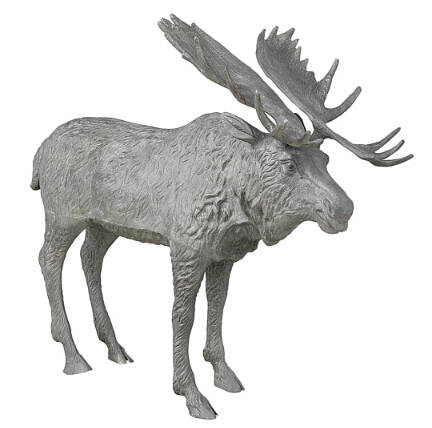There are few things in nature more majestic than a moose, but that doesn’t mean you would want one visiting your garden! A typical adult bull moose is about 6 feet tall and weighs over 1,000 pounds, making the species the largest member of the deer family. Most of us with gardens have seen the devastation a deer can wreak on flowerbeds. Now imagine what an even bigger version could do.
Moose are herbivores and can eat about 50 pounds of plant matter a day, and they aren’t picky about which plants they eat. Gardeners in the northernmost U.S., especially Alaska, know that not much can get between a 1,000-pound animal and the trees, shrubs and vegetables it sees as a snack. Even a six-foot fence, the most reliable deterrent, doesn’t always work. But there are no such worries with this zinc garden figure of a moose, which sold for $3,328 at New Orleans Auction Galleries. At 61 inches tall, it’s about the size of a real moose, antlers and all, but this one will accent your garden plants instead of eating them.
Q: I have two newspapers that I found in a relative’s historical storage box containing research paperwork tracing their lineage. One is “The Rebel,” dated Aug. 9, 1862. The other is “The Daily Citizen” (first edition?) dated July 2, 1863. It is printed on a green floral designed wallpaper. How do I tell if they are authentic?
A: Both of your newspapers have famously been copied and reprinted since the 19th century. The earliest copies were made as souvenirs for G.A.R. reunions. Later ones were made to observe the 50th and 100th anniversaries of the Civil War. “The Daily Citizen” was published by J.M. Swords in Vicksburg, Mississippi. During the Civil War, many publishers in the South ran out of newsprint, so Swords printed issues of “The Daily Citizen” on wallpaper. The July 2, 1863, edition has a note from the Union forces that captured Vicksburg, declaring “This is the last wall-paper edition” and “It will be valuable hereafter as a curiosity.” It is extremely unlikely that your copies are originals. The Library of Congress has online guides to antique newspapers (https://guides.loc.gov/noteworthy-newspaper-issues), including these issues. They list ways to recognize originals (there are certain clues in the size, proportions and certain spellings) and additional resources.
Q: Can you advise me what this platter might be worth? It has a scene printed on it in blue, and the back reads, “Metropolitan Scenery, View of Greenwich.” It is from about 1825. It is 17 by 21 inches. No chips, cracks, or stains. It was my 88-year-old aunt’s father’s. It was given to me before she passed away.
A: The Goodwin pottery firms in the famous English pottery-making district of Staffordshire made a series of “Metropolitan Scenery” tablewares that had prints of notable views in and around London. “View of Greenwich” was one of the designs in the series. This type of scenic pattern is often called “historical china.” Many companies around Staffordshire made it from about 1830 to 1920. These companies, including Goodwin, often changed owners or names, or merged with other companies, so it can be difficult to find information about them. However, you can often identify pottery made in Staffordshire by the presence of a pretzel-shaped knot in the maker’s mark on the back. Staffordshire ceramics with blue scenic patterns like yours are worth about $200.
TIP: Some types of stone and metal remain free of organic stains if they’re left in partial sunlight and heat, but not if in deep shade.
On the block
Current prices are recorded from antiques shows, flea markets, sales and auctions throughout the United States. Prices vary in different locations because of local economic conditions.
Card, advertising, Au Bon Marche, two figures, dressed in red, white and blue, holding American flag, French and English text on reverse, Maison Boucicaut, 4½ by 3 inches, $10.
Furniture, table, sewing, wicker, turned-out edge, woven diamonds, festoon trim, cabriole legs, scrolls, painted, pink, Victorian, 28 inches, $60.
Advertising, sign, Boss’ Biscuits, 5 Cent Packages, list of varieties, black lettering, frame, New London, Connecticut, circa 1880, 17 by 15 inches, $120.
Cloisonne, vase, red panels with phoenix bird, blue panels with butterflies, shoulders, narrow neck, tapered base, Japan, late 19th century, 11 inches, $125.
Bicycle, high wheel, Rideable Bicycle Replicas, 60 spoke front wheel, sun metal rear wheel, circa 1975, 48 inches, $235.
Textile, pillow, Gettysburg 50th Anniversary, eagle carrying flag, crossed cannons, dated, 1913, 17 by 17 inches, $300.
Daum, vase, stick neck, shaded orange, silver overlay branches with leaves and buds, silver marked M Maurio, Daum Nancy, 7 inches, $345.
Beehive, plate, Classical scene, artist painting vase, seated, woman watching, standing, multicolor, gilt rim, “Kusnt bringt Gunst,” Royal Vienna, 9½ inches, $625.
Game, chess, Directoire style, abstract turned pieces, light and dark wood, France, circa 1800, largest piece 1 inch, $955.
Watch, Elgin, Corsica, open face, branch shape Roman numerals, acorn shape indices, gilt leafy scrolls in center, 14K gold, monogram on reverse, 1¾ inches, $1,190.
Talk to us
> Give us your news tips.
> Send us a letter to the editor.
> More Herald contact information.

























